Walt Disney Productions (1951-1961), Walt Disney Home Entertainment (November 11, 2008), 2 disc set, 344 mins. plus supplements, 1.33:1 original full screen ratio and 2:35:1 original widescreen ratio, Dolby Digital, Not Rated, Retail: $32.99
Storyboard:
Well folks, here we are on the final stretch of the landmark Walt Disney Treasures series on DVD. With it, we have finally reached the fourth and final installment of The Chronological Donald series. We have gone through the complete Mickey Mouse, Goofy, and Pluto cartoons and now it is up to Donald to round up Disney’s collection of cartoon stars on DVD. Of course for Donald he is not alone and he brings his cartoons sidekicks with him, including Chip & Dale, Humphrey the Bear, his nephews Huey, Dewey, and Louie, and his girl Daisy Duck. Together, they created some of the funniest cartoons in Donald’s career. The focus may have slowly shifted away from Donald’s persona in these cartoons and towards his antagonists, but that does not mean that these were not great cartoons. Some of my personal favorite cartoons were Chip and Dale cartoons and there are many of them on this great set.

The Sweatbox Review:
The thirty-one shorts highlighted on this disc pick up where the last Chronological Donald left off. We start in 1951 and end in 1961, completing the final decade of Donald’s theatrical solo shorts. The previous collection of shorts already began to see Donald’s transition from the barnyard to the suburbs. In the fifties, this was finally sealed with Donald becoming a suburban everyman with a job and hobbies and living with everyday frustrations of home and family life. In some of these shorts Donald is even married and has a family. This transition was not exclusive to Donald (Goofy underwent the same transition during the fifties), but Donald was the ultimate star at Disney during this time period. The shorts here reflect a new American lifestyle when people were experiencing a new era of prosperity and the open road invited people to explore their own country. Many of the shorts from this time, for example, feature Donald visiting a popular American destination. Of course, towards the end of the fifties, Disney started using Donald as a student to a narrator’s discourse on things such as safety, mathematics, environmentalism, and history.
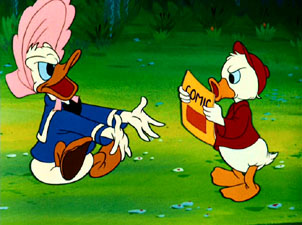
Of course, the fifties also represented a new era for the Walt Disney Studios. In 1950, Disney released Cinderella, their first studio feature length cartoon since Bambi in 1942 (not including the compilation films). The studio was focusing more attention to their feature length movies and Walt Disney started branching out into live action films and television. Disneyland opened in 1955, further dividing the company’s attention and the popularity of cartoon shorts began to wane. They had become expensive to produce and exhibitors were unwilling to pay a higher fee for them. At this point in the studio’s life, the shorts were made almost exclusively to accompany Disney’s feature films and the production levels declined to accompany the pace of feature length production. However, it is my opinion that this was actually something good for the studio. Instead of coming out with one repetitive Donald cartoon after another, the writers, and especially director Jack Hannah, were able to focus on unique and more entertaining storylines for their stars.

By this stage in Donald’s career, the writers were already focusing more and more on Donald’s costars as antagonists to his short fuse and temper. The most prolific of all his costars were the two lovable chipmunks, Chip and Dale. Chip and Dale starred in a total of 23 Disney cartoons, most of which were Donald Duck cartoons. They first appeared in Private Pluto (1943) and would appear again in another Pluto cartoon, Squatter’s Rights (1946) (both of these cartoons can be found on The Complete Pluto, Volume One), before becoming antagonists to Donald Duck in the classic short Chip an’ Dale (1947) (see The Chronological Donald, Volume Three). In this DVD, Chip and Dale costar with Donald in no less than eight cartoon shorts – Corn Chips (1951), Test Pilot Donald (1951), Out of Scale (1951), Donald Applecore (1952), Working for Peanuts (1953), Dragon Around (1954), Up a Tree (1955), and in finally in their excellent final short, Chips Ahoy (1956). In these shorts, Donald usually is enjoying some aspect of his daily life when interrupted by Chip and Dale, and vice-versa. The stories generally work in one of three ways – Chip and Dale discover some source of food Donald doesn’t want them to have (Corn Chips, Donald Applecore, Working for Peanuts), Chip and Dale interrupt one of Donald’s hobbies or restful days (Test Pilot Donald, Chips Ahoy), or Chip and Dale’s tree home is in Donald’s way (Out of Scale, Dragon Around, Up a Tree).
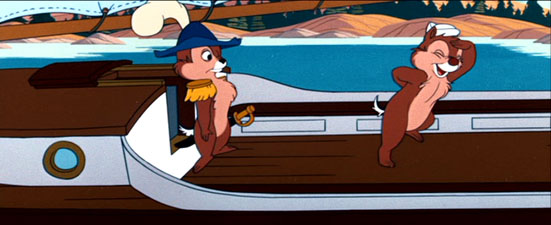
Out of these nine cartoons, three deserve special mention as some of the best or unique Donald Duck cartoons. The first is Out of Scale which is one of my all-time favorite shorts because it really plays with the notion that these two chipmunks are miniature-sized and can see the world from a new perspective. In this short, Donald Duck removes a tree from his backyard because it is out of scale with the miniature train set and town he has built around it. Of course when Chip and Dale return to their home, they find it has been taken away and they decide to then take refuge in the miniature homes Donald has built. The jokes and gags in this short are some of the best on the set and the ending provides a fun conclusion to the story. Chips Ahoy also runs in the same vein as Out of Scale. In this short, Chip and Dale see a tree in the middle of a lake filled with acorns. They then steal Donald’s model boat and make their way to the island. Donald then does everything he can to get his boat back and in the process attempts to teach the chipmunks a lesson. Needless to say, he fails miserably, but not before Chip and Dale have a fun time getting back at him to the best of their abilities. Finally, we have Working for Peanuts, which is not one of the best Donald Duck shorts, but is unique because of the special 3D technology that was used in the making of the film. While the short here is not presented in 3D, one can easily see the visual gags that would have worked in 3D.
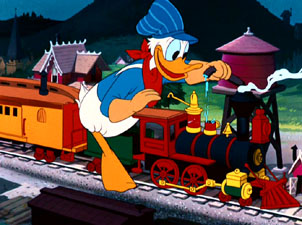
As a side note, Chip and Dale would also appear in three of their very own shorts during this time period (none of which are included on this DVD) – Chicken in the Rough (1951), Two Chips and a Miss (1952), and The Lone Chipmunk (1954). I wish these had been included in this set as a bonus, but for those that are interested, Chicken in the Rough and Two Chips and a Miss can be found on Classic Cartoon Favorites, Volume 4 – Starring Chip and Dale. As of today, The Lone Chipmunk is the lone Chip and Dale cartoon not available on DVD. Maybe Disney will eventually release a Treasure set with One-time cartoons, but for now one can only hope.
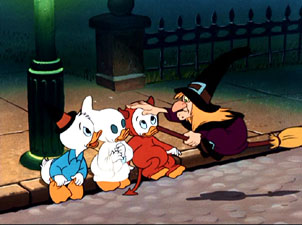
Donald’s nephews and his girlfriend Daisy also make several appearances in this set. Huey, Dewey, and Louie first appeared in the Donald Duck short Donald’s Nephews in 1938 and would continue to appear in his shorts for years to come. In this set, they make prominent appearances (as his nephews) in Lucky Number (1951), Trick or Treat (1952), Don’s Fountain of Youth (1953), Canvas Back Duck (1953) and Spare the Rod (1954). There are kids who appear in other cartoons that bear similarities to his nephews, but it’s difficult to say if these were intentional or coincidental. Most of the shorts featuring Donald’s nephews have him playing a prank on them or him trying to teach him a lesson usually to disastrous effects. In Lucky Number, one of the best shorts in this group, Donald’s nephews fool him into giving them gas for free so they can go get him a new car. Donald, noticing the deception, then proceeds to destroy the new car they get for him. In Don’s Fountain of Youth, a prank on his nephews where he pretends to grow younger leads to an extended chase sequence involving an angry mother alligator. As for Daisy Duck, she makes two appearances on this set, one in Donald’s Diary (1954), where she does everything she can to seduce a bachelor Donald, and another where she (or someone extremely like her) appears as his wife in the educational short How to Have an Accident at Work (1959).

The third and final pair of antagonists to Donald are Humphrey the Bear and a Ranger who first appear together in the short Grin and Bear It (1954). In this short, Donald visits Brownstone Park where the Ranger is giving instructions to tourists, including Donald, about how to treat the bears. The Ranger also warns the bears, and specifically Humphrey, that they need to behave and refrain from stealing the visitor’s food. Humphrey, of course, cannot keep away from Donald’s basket and constantly tries to get at some of his food. Humphrey the Bear first appeared in the Goofy short Hold that Pose (1950) before costarring with Donald in three more cartoons – Bearly Asleep (1955), Beezy Bear (1955), and Rugged Bear (1953) – an excellent Academy Award nominated cartoon. Beezy Bear would also reteam Humphrey with the Ranger who also costarred with Donald in the landmark cartoon Grand Canyonscope (1954). Grand Canyonscope was a landmark cartoon because it was the first time a classic Disney cartoon star would be featured in Cinemascope. What makes the visual effect even more remarkable are the beautiful backgrounds designed by Disney legend Eyvind Earle. In the cartoon, Donald visits the Grand Canyon and is shown around by the Ranger until he meets a mountain lion who chases him around the park, as usual to disastrous conclusions. Humphrey the Bear and the Ranger would later star in two more of their own cartoons in 1955 – Hooked Bear and In the Bag. Like the three Chip and Dale cartoons, neither one of these two cartoons are found on this DVD (or in any other that I know of).

Donald also starred with a couple of one-time antagonists in some of the shorts in this set. These include a reluctant horse in Dude Duck (1951), a honeybee in Bee on Guard (1951) and in Let’s Stick Together (1952), a nasty neighbor (Pete) in The New Neighbor (1953), a Chip-and-Dale-like squirrel in The Flying Squirrel (1954), hungry ants in Uncle Donald’s Ants (1952), and an ancestor’s spirit in the Academy Award nominee No Hunting (1955).
Towards the very end of his career, Donald began starring in a series of educational shorts that were made to teach people about safety, the environment, and school subjects. Perhaps the most famous of these shorts is Donald in Mathmagic Land (1959), a short that people have been speculating for years if it was going to be included in a Treasure set. Well, it’s finally here and it’s a very entertaining and informational short. In this short, Donald ventures into Mathmagic Land where he learns that math is found in many different places – from music to architecture. A narrator tells the story of math from the ancient Greeks to modern day applications. A similar approach is used in Donald and the Wheel (1961) where a prehistoric version of Donald is taught about the wheel and the applications it will have in the future. This is my least favorite short on the disc, mainly because of the two live-action shadow narrators of the story who are supposed to be the Spirits of Progress, but really sounds like they are stuck in the 60s based on their speech and slang. There is also a set of shorts about safety called How to Have an Accident at Home (1956) and How to Have an Accident at Work (1959). These shorts feature Donald making very poor and unsafe decisions at home and at work and blaming his misfortune on fate. Both of these shorts are narrated by a character called J.J. Fate. Finally, the final short on the DVD is The Litterbug (1961), which was one of Donald’s last shorts made mostly for entertainment, although in this case it also educates the viewer about littering and how it is destroying the environment.

The From the Vault section on the DVD includes five politically-incorrect cartoons. Leonard Maltin introduces this group of shorts and discusses the sensitive nature of these cartoons and asks us to consider them as products of their time. One cannot skip Maltin’s introduction to the section. Once in this section, one can choose to watch them one at a time or play all of them. The cartoons in this section are Uncle Donald’s Ants (which features Native American caricatures and stereotypes on ants), Rugged Bear (which features prominent use of hunting and rifles), Spare the Rod (which features pygmy cannibals who try and eat Donald), No Hunting (which has a brief depiction of an Indian guide an excessive use of guns), and How to Have an Accident at Work (most likely for a questionable Chinese caricature).
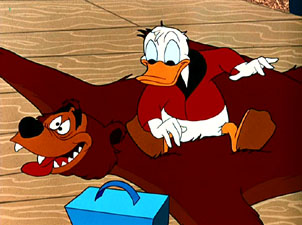
Is This Thing Loaded?
The bonus features of this DVD set are spread out over the two discs. The first disc includes the featurettes Donald Goes to Press and The Unseen Donald Duck: Trouble Shooters as well as audio commentary for Working for Peanuts by Leonard Maltin and Jerry Beck. The second disc features audio commentary on Grand Canyonscope by Leonard Maltin and Jerry Beck as well as a slew of Mickey Mouseworks Cartoons.
Donald Goes to Press (12:48) is an informative featurette about the world and history of Donald Duck in comic books. This is my favorite featurette on this disc, partly because I grew up reading Donald Duck comics. It was interesting to see how the character developed differently from the theatrical shorts and how his personality and stories differed in Europe and America. The short documentary gives tribute to the incredible talents of artists from around the world for the development of Donald Duck in comic book form and gives them credit for keeping him entertaining long after Disney stopped producing theatrical shorts.
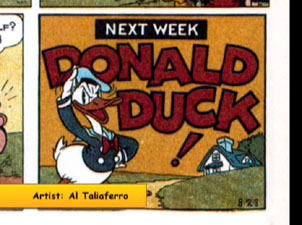
The second featurette, The Unseen Donald Duck: Trouble Shooters (10:13), features Eric Goldberg and Leonard Malting talking about an unfinished Donald Duck short that was storyboarded but never animated. Goldberg then proceeds to give a storyboard pitch as they would have done back in the days when Walt Disney used to make the decisions on which shorts to produce. The short features Donald as a telephone utility worker who battles a woodpecker when he goes to fix a telephone cable. It would have been a funny short if it had been animated and it is a fun bonus feature to include in the set. One can tell that Goldberg and Maltin are having a great time talking about Donald and his career.
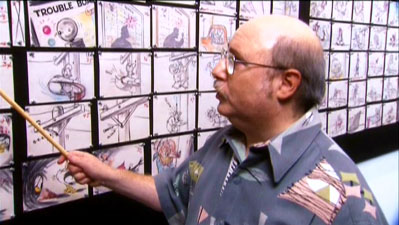
Both discs one and two feature audio commentary tracks by Jerry Beck and Leonard Maltin on selected shorts. On the Working for Peanuts commentary, Beck and Maltin talk about the use of 3D animation in the short and about the heyday of 3D use in Hollywood. They also talk about the makers and designers of the short. I thought it was interesting to learn that this is one of the most played shorts since it was featured in both Disneyland and Disney World at their 3D theatres. The second disc features a commentary track for Grand Canyonscope. In their commentary, Beck and Maltin talk about the use of Cinemascope at Disney and the many innovations they were implementing at the time – including Stereophonic sound. They also discuss the character of the Ranger and the voice work of Bill Thompson. Both of these commentary tracks are very informative and entertaining and with their short running time I invite all fans to have a listen at least once.
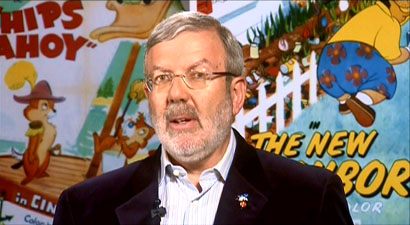
The main bonus feature on the second disc is a selection of Mickey Mouseworks shorts featuring Donald Duck. Mickey Mouseworks was a show that premiered in 1999 on ABC that featured classic Disney cartoon characters like Mickey Mouse and Donald Duck in new, original shorts. The show was fairly popular and ran for two seasons before it was replaced with House of Mouse, a similar-themed show. What Disney aimed to do with these shows was to reintroduce their classic characters to a new generation. I had never watched the show before, so I was pleasantly surprised by the quality of the story and animation that I found in the cartoons. The total running time of these shorts is over one hour! That’s not bad for a bonus feature and it was a pleasant surprise for me. When you consider the 10 Mickey Mouseworks cartoons presented in this set, the number of Donald Duck shorts jumps from 31 to 41 on this set. Keeping with the theme of Donald career, many of these shorts feature Daisy, his nephews and Chip and Dale as costars.

The Mickey Mouseworks Cartoons are as follows: Bird Brained Donald, Donald and the Big Nut, Donald’s Charmed Date, Donald’s Dinner Date, Donald’s Failed Fourth, Donald’s Rocket Ruckus, Donald’s Shell Shots, Donald’s Valentine Dollar, Music Store Donald, and Survival of the Woodchucks. There are also final credits available for the cartoons in their own chapter.
Leonard Maltin is the host of this two-disc set and he also provides a brief video introduction before showing the main menu on each disc. In the first disc, Maltin talks about how enduring a character Donald Duck became at Disney and he also discusses how Disney used new techniques in his shorts. He also outlines the bonus features on the disc. On the second disc, Maltin talks about the special talent behind the Donald cartoons including the voice casts and musical talents. He then talks about the special features on the set and how the Disney Studios TV Animation Department – by way of Tony Craig and Bobs Gannaway – revived the classic characters in 1999 with Mickey MouseWorks.
Case Study:
Once again, Disney has released this special collector’s set in a special tin encasing. The tin has a picture from the short Chips Ahoy on the cover and lists the title as The Chronological Donald – Volume Four with the subheading 1951-1961. Inside the tin is a two-disc wide keepcase with only one compartment similar to the last couple of waves (instead of the two compartments featured in the first waves). The difference this time is that the DVDs are featured mounted on top of one another instead of having a separate flap for the second disc. The two discs therefore overlap one another with Disc One featured on top of Disc Two. Inside the case is an insert for Disney Blu-Ray titles, a Certificate of Authenticity showing the number of your edition (out of 39,500 copies), and a lithograph copy of the theatrical poster for Grin and Bear It.
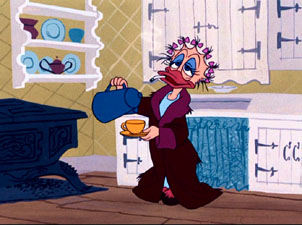
Ink And Paint:
The most significant aspect of this edition compared to past editions of the Walt Disney Treasure line is that we are finally treated cartoons being released in their original Cinemascope glory. Disney started releasing their shorts in Cinemascope to accompany the feature films that were coming out at the time in the same format. Disney himself was already planning to release Lady and the Tramp in the same format. One can find several restored Cinemascope cartoons on this DVD with their original widescreen title cards and animation. Grand Canyonscope is the landmark cartoon, but many others afterwards were released in the same format. Personally, I was most glad to see one of my favorite cartoons, Chips Ahoy, for the first time in widescreen. The colors here are beautiful and meticulously painted as in most Disney cartoons. It was a treat for me to see the artwork by the likes of famous Disney artists like Eyvind Earle finally make it to widescreen. In keeping with the theme, many of the interviews in the bonus features section are also featured in widescreen.

Scratch Tracks:
Along with Cinemascope, Disney also enhanced their musical and sound tracks at the time by introducing Stereophonic sound into their cartoons. When Grand Canyonscope came out, they used a scene with an echo to play with the format and it was a way for the company to experiment for use in their feature-length features. The audio here is presented in an English Dolby Digital 2.0 track with English subtitles also available for the shorts, bonus features, and commentaries. The special features are featured in Dolby Digital 5.1.
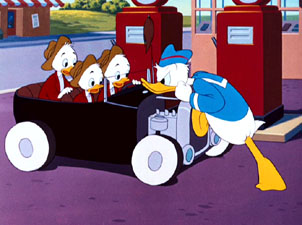
Final Cut:
This release is supposed to round up the final Donald Duck shorts available, but there are others. This is by no means the complete collection, but I think it is as close as we are going to get in a while. There are several other Donald Duck educational shorts, but one can defend Disney’s exclusion from this set by admitting that they were not exactly Donald Duck cartoons to begin with. I, for one, am happy that we at least got Donald in Mathmagic Land included in the set. This was always a doubt of mine from the very beginning when we hypothesized on what was to be included in this final set (or a proposed Educational Shorts set). I am a little disappointed that the solo Chip and Dale and Humphrey the Bear shorts were not included as bonus features, but this was more of a wish of mine since it is difficult to see in what other way they would ever be released. Still, maybe it is a missed opportunity. However, I still have to recommend this set. It features many excellent Donald Duck shorts at a time when Disney artists were not making as many shorts. That is a testament to the endurance of Donald Duck and the timelessness of his stories.
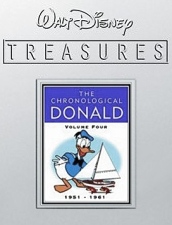 | ||
 |






